TEMPOROMANDIBULAR JOINT TUMORS
- Magnetic resonance imaging, computed tomography, and cone beam volume computed tomography are useful and complementary in the evaluation of the temporomandibular joint and are the studies that are most frequently pivotal in medical decision making.
- Computed tomography and cone beam volume computed tomography are the best studies for evaluating bone detail and calcifications.
- Magnetic resonance imaging is the best study to evaluate the articular disk and other intra-articular soft tissues.
- Magnetic resonance imaging is the best study to provide some information about joint mechanics, the articular disk, and other intra-articular soft tissues.
- Periarticular problems may mimic a primary temporomandibular joint problem; imaging protocols and evaluation of images must include some attempt to screen the anatomy around the joint.
- Screening of surrounding soft tissue structures is limited with cone beam volume computed tomography.
The vast majority of tumors affecting the temporomandibular joint (TMJ) are extrinsic to the joint. These arise from the skin of the temporal bone and periauricular region, the parotid gland, parapharyngeal spaces, or masticator space, or they may be due to metastatic disease or a systemic malignancy such as lymphoma or plasma cell dyscrasia. Occasionally, a TMJ-origin tumor will mimic one rising from one of these extrinsic sites (Fig. 103.1).
It is very important to understand that tumors of structures surrounding the TMJ may present with TMJ pain or dysfunction; thus, images of the TMJ done with protocols dedicated to the evaluation of internal derangement must be searched for such extrinsic pathology (Fig. 103.1D,E).
Benign or malignant tumors that arise primarily from the TMJ most often are of bony origin (Fig. 103.1A–C). Tumors of other origin other than metastases are very uncommon.
TECHNICAL ASPECTS
General Examination Technique
The imaging approach to the TMJ is discussed in Chapter 101, where specific recommendations about section thickness and other image acquisition parameters are suggested. Multidetector computed tomography, cone beam volume computed tomography (CBVCT), and magnetic resonance imaging (MRI) are all used for advanced imaging for some indications (Table 4.1). Plain films, including panoramic views, remain a standard and reasonable starting point for the study of the TMJ. Advanced imaging studies are reserved for more complex clinical decision making, and almost all tumors will eventually come to such an evaluation. Computed tomography (CT) for possible TMJ tumors may be done without intravenous (IV) contrast. Realistically, IV contrast has often been used because a site of some other origin was suspected. Specific CT protocols are presented in Appendix A.
MRI is done in selected cases and may be done with a combined technique suitable for evaluating the TMJ for an internal derangement as well as the surrounding structures with a protocol appropriate for the masticator space and parotid gland. Tumors are studied before and after IV contrast. Such magnetic resonance protocols are presented in Appendix B.
It is very important to understand that tumors of structures surrounding the TMJ may present with TMJ pain or dysfunction. Protocols dedicated to the evaluation of internal derangement must include at least one axial sequence showing both sides to screen for such pathology.
General Imaging Appearance
The pathophysiology and general imaging appearance of head and neck tumor diseases are discussed in Chapter 21, and those of bone and cartilage origin are discussed in Chapters 38 and 39. Unique features of TMJ tumors are related to their effect on the joint and relationship to the temporal bone and remainder of the skull base, the masticator space, and to the parotid gland and facial nerve.
BENIGN AND MALIGNANT TUMORS
Patients with the very uncommon benign and malignant tumors involving the TMJ often present with signs and symptoms identical to those of dental pathology disease (Figs. 103.2 and 103.3); thus, these patients usually have had at least dental-type plain films, non–contrast-enhanced CT, or CBVCT by the time a tumor is confirmed by biopsy. A supplemental MRI may be useful. MRI in these cases is usually focused on clarifying specific issues that may critically alter patient management, such as the extent of involvement beyond the TMJ and the presence and extent of perineural spread.
One useful approach to these conditions is to determine whether they arise intrinsic or extrinsic to the joint structures. Once that is established, a more specific odds determination can be reported with regard to the specific tissue or joint component of origin as well as the odds of it being benign or malignant.
Extrinsic
These tumors arise from the following sources:
 Skin of the temporal bone and periauricular region (Chapters 24, 121, and 122).
Skin of the temporal bone and periauricular region (Chapters 24, 121, and 122).
 Parotid gland (Chapter 199). These masses are mainly benign tumors and cysts but sometimes malignant epithelial lesions, nodal metastases mainly from skin cancer, and rarely other malignant tumors.
Parotid gland (Chapter 199). These masses are mainly benign tumors and cysts but sometimes malignant epithelial lesions, nodal metastases mainly from skin cancer, and rarely other malignant tumors.
 Masticator space (Chapter 145). Neurogenic tumors (sometimes transcranial) are likely the most common of these very uncommon tumors, followed by transcranial meningiomas (Fig. 103.4), sarcomas (Figs. 103.1A and 103.3), and lymphoma.
Masticator space (Chapter 145). Neurogenic tumors (sometimes transcranial) are likely the most common of these very uncommon tumors, followed by transcranial meningiomas (Fig. 103.4), sarcomas (Figs. 103.1A and 103.3), and lymphoma.
 Metastatic disease or a systemic malignancy such as lymphoma.
Metastatic disease or a systemic malignancy such as lymphoma.
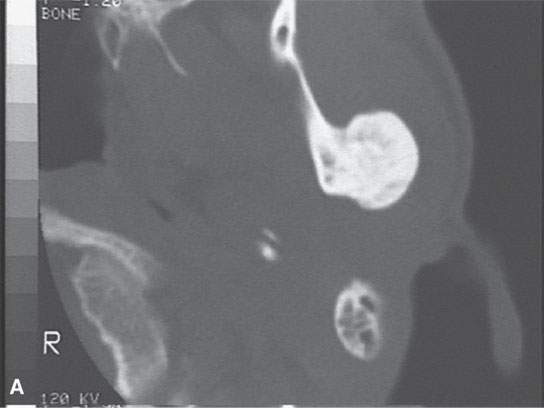
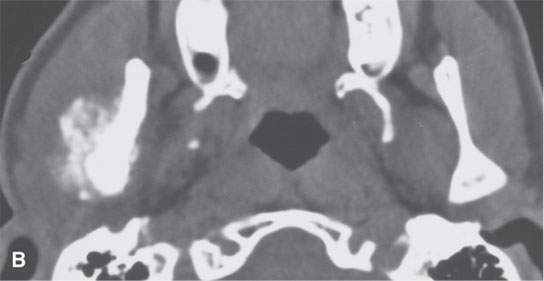
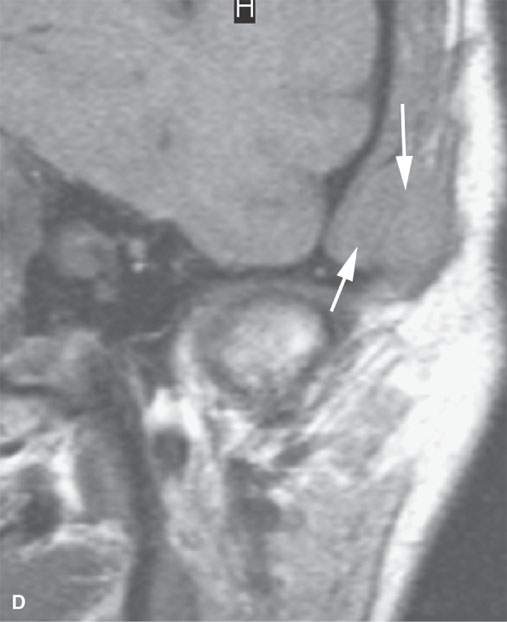
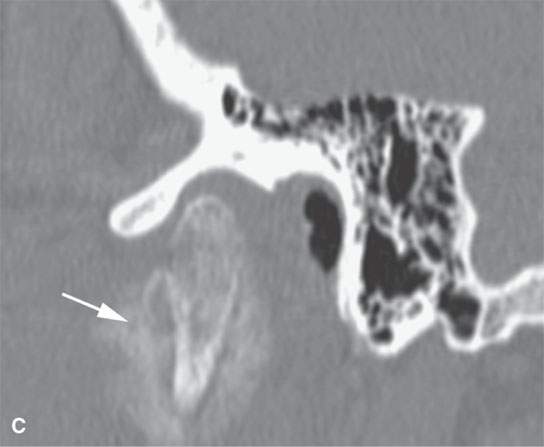
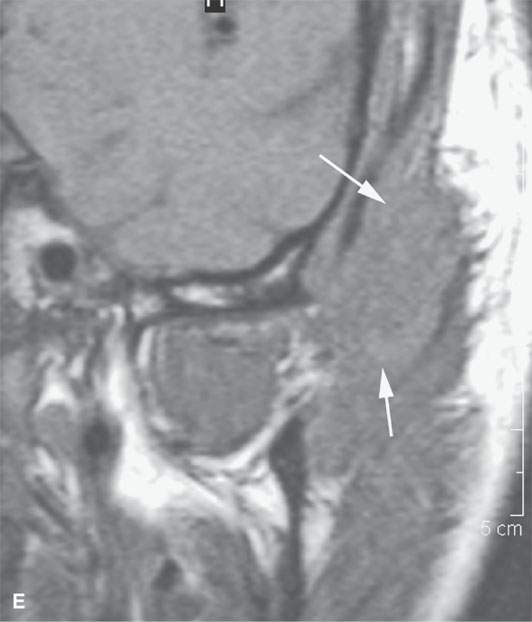
FIGURE 103.1. Four patients presenting with masses arising from structures of or intimately associated with the temporomandibular joint (TMJ) as parotid region masses or an incidental finding. A: Computed tomography (CT) study of Patient 1, believed to have a parotid mass. No imaging was done initially. Biopsy returned normal parotid tissue. Subsequent imaging showed this to be an osteochondroma. B: CT study of Patient 2 presenting with what was thought to be a parotid region mass. CT showed an osteosarcoma that eventually was proven by CT-guided biopsy arising from the junction of the condylar head and neck. C: CT study showing a prostate metastasis in Patient 3 presenting with pain and a palpable mass in the region of the parotid gland. Initial diagnostic consideration was parotid malignancy. D, E: Patient 4 studied with magnetic resonance imaging for pain in the TMJ region and possible internal derangement. This sarcoma (arrows) in D was initially missed. The patient returned after some months, and the mass had grown substantially as seen in E (arrow).
Stay updated, free articles. Join our Telegram channel

Full access? Get Clinical Tree








